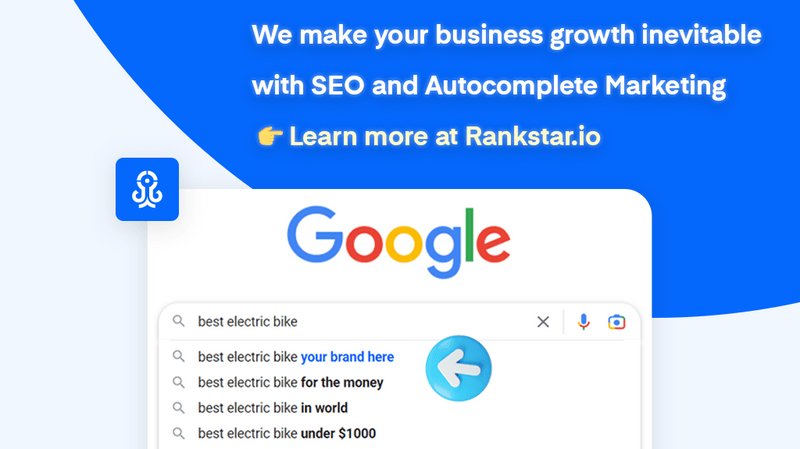You’re about to master the perfect blend of SEO and UX, two key elements for a triumphant website.
You’ll learn how SEO boosts your site’s visibility, while UX enhances user interaction.
We’ll explore their synergy, showing you how a user-centric approach can influence your website’s success.
So, get ready to dive into a world where search engine algorithms and user-friendly designs unite.
Let’s unlock the power of the dynamic duo, shall we?
Key Takeaways
- SEO and UX are both important for the success of a website.
- Balancing SEO and UX is crucial for creating a website that ranks well and provides a great user experience.
- Google considers user experience as a ranking factor and penalizes sites that have bad user experience.
- Positive user signals, such as easy-to-use navigation and fast page speed, can improve both UX and SEO.
Rankstar – A Valuable SEO Partner for Your Business
→ Discover the unbeatable partnership for website success in our latest article on Rankstar!
Dive into the world of SEO and user experience and learn how this dynamic duo can transform your website’s performance. Don’t miss this chance to elevate your digital presence—read the full article now and unleash the power of SEO and UX for website success!
We are also here to propel your brand to the summit of search rankings, ensuring its outstanding prominence in both Autocomplete Suggestions and Autosuggest Removal when in need.

Understanding the Basics of SEO and UX
You’re now delving into the basics of SEO and UX, crucial components that can significantly enhance the visibility and user experience of a website.
SEO, or Search Engine Optimization, is all about improving your site’s ranking on search engine result pages. It’s about using relevant keywords, optimizing your pages, and building quality backlinks. You’re not just attracting any traffic, but the kind that’s likely to convert.
On the other hand, UX, or User Experience, is about making your site enjoyable for users. You’re aiming for a design that’s not only visually appealing but also easy to navigate. A good UX keeps visitors on your site longer, making them more likely to become customers.
The Interplay Between SEO and UX
During your journey in understanding SEO and UX, you’ll soon discover that while SEO pulls users to your site, it’s UX that keeps them around, and over time, both components become intertwined for the success of a website.
Here’s a simple breakdown:
- SEO: It’s all about making your site visible and attractive to search engines, thus drawing users in.
- UX: Once users are on your site, UX takes the wheel. It’s about creating a seamless, enjoyable experience that keeps users engaged and coming back for more.
- Interplay: The magic happens when SEO and UX work in harmony. Good UX boosts SEO by reducing bounce rates and increasing time spent on the site.
- Balance: Striking the right balance between SEO and UX is key. One shouldn’t overshadow the other, as both are vital for a successful website.
How Google Values User Experience
Understanding how Google values user experience can drastically improve your site’s SEO ranking. It’s essential to remember that a user-friendly site often translates to a Google-friendly site. Google’s algorithms assess UX through various metrics, such as page load speed, mobile-friendliness, and bounce rates. Improving these factors can enhance your site’s user experience, making it more appealing to both users and Google.
Incorporate UX principles into your SEO strategy. Streamline navigation and increase page speed, both of which can boost user engagement and reduce bounce rates. Remember, Google rewards sites that provide valuable, user-centric content. By focusing on UX alongside SEO, you’re not just driving traffic to your site, you’re ensuring that users stay longer, engage more, and hopefully convert. And Google will take notice.
SEO and UX: A Symbiotic Relationship
In the realm of website optimization, you’ll find that SEO and UX aren’t just related, but they’re symbiotic, each enhancing the effectiveness of the other. The magic happens when you strike a balance between the two.
- SEO drives traffic: Your meticulously researched keywords and high-quality content pull in the audience.
- UX keeps them engaged: Once they’re in, an intuitive, user-friendly design keeps them there.
- SEO and UX boost your ranking: Google rewards websites that cater to their users’ experience. The longer users stay and interact with your site, the more Google sees it as valuable.
- They feed off each other: Great UX leads to lower bounce rates, more shares, and backlinks, all of which indirectly boost your SEO.
In essence, when SEO and UX are symbiotically aligned, they create an optimized, user-friendly site that ranks well with search engines.
The Impact of SEO on Your Site
You’ve got to realize that SEO can significantly increase your site’s visibility, but it’s also essential to understand that improper SEO strategies can negatively impact your site’s performance and user experience. If your website isn’t properly optimized, it can lead to lower rankings, resulting in less organic traffic. On the other hand, a well-optimized site can climb the search rankings, attracting more visitors. But remember, SEO isn’t just about attracting traffic; it’s about delivering a user-friendly experience too.
| SEO Pros | SEO Cons |
|---|---|
| Increases visibility | Improper use can hurt rankings |
| Attracts more organic traffic | Over optimization can lead to penalties |
| Improves user experience when done right | Can be time-consuming |
| Potentially higher conversion rates | Results aren’t immediate |
| Builds brand credibility | Requires regular updates and monitoring |
Striking a balance between SEO and UX is critical for your website’s success. Always prioritize your users’ needs and preferences when implementing SEO strategies.
The Role of User Experience in Website Success
Optimizing your website’s user experience can dramatically boost its success by fostering visitor engagement and satisfaction. It’s essential to understand the importance of UX in the digital landscape. Here’s why:
- Simplicity: Users prefer a site that’s easy to navigate. Declutter your site, keeping it simple and intuitive.
- Speed: If your site takes too long to load, users may leave. Optimize your site’s speed for better user engagement.
- Mobile Optimization: With the majority of users browsing on mobile devices, a mobile-optimized site is crucial.
- Relevant Content: High-quality, relevant content satisfies user queries and keeps them coming back.
Essential Elements of a Well-Optimized Website
To create a well-optimized website, you’ll need to focus on elements such as speed, mobile optimization, relevant content, and a user-friendly layout, all of which will have a significant impact on both SEO and UX.
Speed plays a crucial role in user satisfaction and Google rankings; a slow-loading site will turn users away.
Mobile optimization is no longer optional as more people are accessing the web via mobile devices.
Relevant content attracts and retains users, and it also signals to search engines that your site is a valuable resource.
Finally, a user-friendly layout ensures that visitors can easily navigate your site, enhancing their experience and increasing the likelihood of conversions.
Balancing these elements skillfully is the key to a successful, well-optimized website.
User-Centric Approach: Key to Website Success
While you’re creating a website, remember that a user-centric approach is vital, as it not only improves the user’s experience but also boosts your site’s SEO performance. Your website should be designed with the user in mind, making navigation intuitive and content easily accessible.
Here are four key principles to follow:
- Usability: Make sure your site is easy to navigate. Users should be able to find what they’re looking for quickly.
- Relevancy: Your content should be relevant and valuable. Users should find answers to their questions or solutions to their problems.
- Design: A clean, attractive design can enhance a user’s experience.
- Performance: Your site should load quickly and run smoothly, as performance affects both user experience and SEO.
How to Improve Your Website’s SEO and UX
You’ve got numerous strategies at your disposal to enhance both your website’s SEO and UX, helping you attract more visitors and keep them engaged for longer.
Start by researching relevant keywords to optimize your content for search engines. Use these keywords naturally throughout your site, in your meta descriptions, and in your title tags.
But don’t stop at SEO. Prioritize your user’s experience by ensuring your site’s navigation is intuitive and your content is engaging. Make your site mobile-friendly and decrease your page load time. Remember, a user-friendly website not only keeps visitors on your site longer but also boosts your SEO.
Lastly, keep your content fresh, relevant, and valuable. By marrying SEO and UX strategies, you’re well on your way to website success.
Case Studies: Successful Integration of SEO and UX
In this section, we’ll dissect some case studies that showcase successful integration of SEO and UX, and you’ll see how these two elements can work hand in hand to boost website performance.
- Case 1: A major e-commerce site enhanced its UX design to facilitate smoother navigation, which in turn improved its bounce rate. Coupled with strategic keyword optimization, it witnessed a 30% boost in organic traffic.
- Case 2: An online blog implemented a mobile-friendly design, improving its UX. With added SEO efforts like meta tags and header optimization, its search rankings surged.
- Case 3: A local business website invested in high-quality content, satisfying both UX for engaged readers and SEO for Google’s algorithms.
- Case 4: An online magazine redesigned its site to decrease load time, a UX win that also benefited SEO by reducing bounce rates.
These cases clearly show the synergy between SEO and UX in achieving website success.
Frequently Asked Questions
How Can a Business Determine if Their Website’s SEO and UX Are Effectively Working Together?
You can assess if your website’s SEO and UX are in sync by checking your site’s ranking, organic traffic, bounce rate, and conversion rate. If these metrics are positive, they’re effectively working together.
What Are Some Common Mistakes Businesses Make When Trying to Balance SEO and Ux?
You might focus too much on keywords, neglecting content quality. You could also over-complicate the design, making navigation difficult. It’s essential to balance SEO tactics with a user-friendly design for optimal website performance.
How Does the Integration of SEO and UX Impact a Website’s Conversion Rates?
Integrating SEO and UX boosts your website’s conversion rates. SEO drives traffic, while good UX enhances user engagement. Together, they ensure your site is both findable and enjoyable, leading to higher visitor retention and conversions.
Can You Provide Specific Examples of How UX Designs Have Positively Affected a Website’s SEO Performance?
Sure, when you improve UX design by enhancing site speed or mobile responsiveness, it benefits SEO by reducing bounce rates. Also, a clear, user-friendly layout increases dwell time, further boosting your SEO performance.
How Can a Business Track and Measure the Success of Their SEO and UX Strategies?
You can track your SEO and UX success through various metrics like organic traffic, bounce rate, conversion rate, and user engagement time. Use analytics tools like Google Analytics for accurate measurement and tracking.
Conclusion
In conclusion, SEO and UX are the dynamic duo driving your website’s success. By understanding and integrating both, you can boost your site’s visibility, attract a larger audience, and provide a stellar user experience.
Don’t underestimate their power. Make your website not just search engine friendly, but also user-friendly. Remember, a user-centric approach is the key to success.
Keep learning, keep optimizing, and watch your website thrive.


















